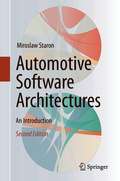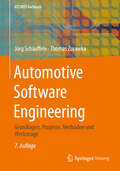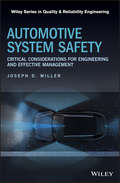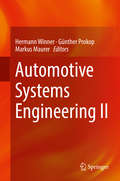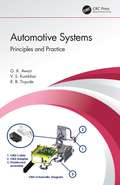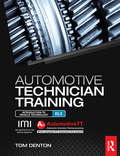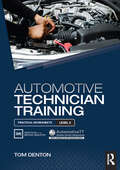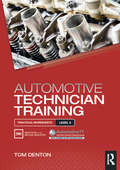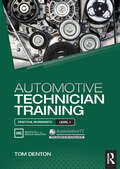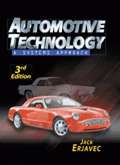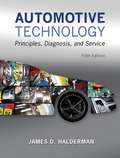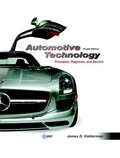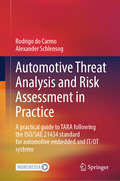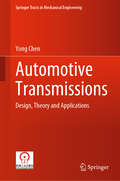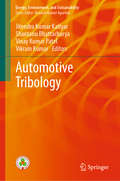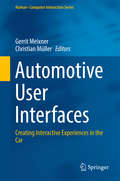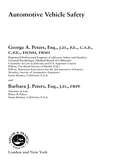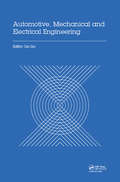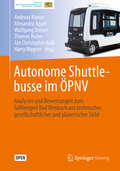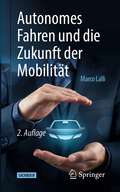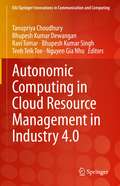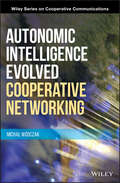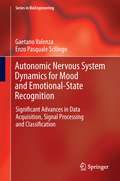- Table View
- List View
Automotive Software Architectures: An Introduction
by Miroslaw StaronThis book introduces the concept of software architecture as one of the cornerstones of software in modern cars. Following a historical overview of the evolution of software in modern cars and a discussion of the main challenges driving that evolution, Chapter 2 describes the main architectural styles of automotive software and their use in cars’ software. Chapter 3 details this further by presenting two modern architectural styles, i.e. centralized and federated software architectures. In Chapter 4, readers will find a description of the software development processes used to develop software on the car manufacturers’ side. Chapter 5 then introduces AUTOSAR – an important standard in automotive software. Chapter 6 goes beyond simple architecture and describes the detailed design process for automotive software using Simulink, helping readers to understand how detailed design links to high-level design. The new chapter 7 reports on how machine learning is exploited in automotive software e.g. for image recognition and how both on-board and off-board learning are applied. Next, Chapter 8 presents a method for assessing the quality of the architecture – ATAM (Architecture Trade-off Analysis Method) – and provides a sample assessment, while Chapter 9 presents an alternative way of assessing the architecture, namely by using quantitative measures and indicators. Subsequently Chapter 10 dives deeper into one of the specific properties discussed in Chapter 8 – safety – and details an important standard in that area, the ISO/IEC 26262 norm. Lastly, Chapter 11 presents a set of future trends that are currently emerging and have the potential to shape automotive software engineering in the coming years. This book explores the concept of software architecture for modern cars and is intended for both beginning and advanced software designers. It mainly aims at two different groups of audience – professionals working with automotive software who need to understand concepts related to automotive architectures, and students of software engineering or related fields who need to understand the specifics of automotive software to be able to construct cars or their components. Accordingly, the book also contains a wealth of real-world examples illustrating the concepts discussed and requires no prior background in the automotive domain. Compared to the first edition, besides the two new chapters 3 and 7 there are considerable updates in chapters 5 and 8 especially.
Automotive Software Engineering: Grundlagen, Prozesse, Methoden und Werkzeuge (ATZ/MTZ-Fachbuch)
by Jörg Schäuffele Thomas ZurawkaDieses Fachbuch enthält die Grundlagen sowie zahlreiche Anregungen und praktische Beispiele zu Prozessen, Methoden und Werkzeugen, die zur sicheren Beherrschbarkeit von elektronischen Systemen und Software im Fahrzeug beitragen. Dabei werden der AUTOSAR-Standard und die Norm ISO 26 262 durchgehend behandelt. Die aktuelle Auflage berücksichtigt Elektro- und Hybridantriebskonzepte sowie Fahrerassistenzsysteme und enthält die Grundlagen zu Produktlinien- und Variantenmanagement. Seit Anfang der 1970er Jahre ist die Entwicklung von Kraftfahrzeugen geprägt von einem rasanten Anstieg des Einsatzes von Elektronik und Software. Dieser Trend hält bis heute an und wird getrieben von steigenden Kunden- und Umweltanforderungen. Nahezu alle Funktionen des Fahrzeugs werden inzwischen elektronisch gesteuert, geregelt oder überwacht. Die Realisierung von Funktionen durch Software bietet einzigartige Freiheitsgrade beim Entwurf. In der Fahrzeugentwicklung müssen jedoch Randbedingungen wie hohe Zuverlässigkeits- und Sicherheitsanforderungen, lange Produktlebenszyklen, begrenzte Kostenrahmen, kurze Entwicklungszeit und zunehmende Variantenvielfalt berücksichtigt werden. In diesem Spannungsfeld steht Automotive Software Engineering.
Automotive System Safety: Critical Considerations for Engineering and Effective Management (Quality and Reliability Engineering Series)
by Joseph D. MillerContains practical insights into automotive system safety with a focus on corporate safety organization and safety management Functional Safety has become important and mandated in the automotive industry by inclusion of ISO 26262 in OEM requirements to suppliers. This unique and practical guide is geared toward helping small and large automotive companies, and the managers and engineers in those companies, improve automotive system safety. Based on the author’s experience within the field, it is a useful tool for marketing, sales, and business development professionals to understand and converse knowledgeably with customers and prospects. Automotive System Safety: Critical Considerations for Engineering and Effective Management teaches readers how to incorporate automotive system safety efficiently into an organization. Chapters cover: Safety Expectations for Consumers, OEMs, and Tier 1 Suppliers; System Safety vs. Functional Safety; Safety Audits and Assessments; Safety Culture; and Lifecycle Safety. Sections on Determining Risk; Risk Reduction; and Safety of the Intended Function are also presented. In addition, the book discusses causes of safety recalls; how to use metrics as differentiators to win business; criteria for a successful safety organization; and more. Discusses Safety of the Intended Function (SOTIF), with a chapter about an emerging standard (SOTIF, ISO PAS 21448), which is for handling the development of autonomous vehicles Helps safety managers, engineers, directors, and marketing professionals improve their knowledge of the process of FS standards Aimed at helping automotive companies—big and small—and their employees improve system safety Covers auditing and the use of metrics Automotive System Safety: Critical Considerations for Engineering and Effective Management is an excellent book for anyone who oversees the safety and development of automobiles. It will also benefit those who sell and market vehicles to prospective customers.
Automotive Systems Engineering
by Hermann Winner Markus MaurerThis book reflects the shift in design paradigm in automobile industry. It presents future innovations, often referred as "automotive systems engineering". These cause fundamental innovations in the field of driver assistance systems and electro-mobility as well as fundamental changes in the architecture of the vehicles. New driving functionalities can only be realized if the software programs of multiple electronic control units work together correctly. This volume presents the new and innovative methods which are mandatory to master the complexity of the vehicle of the future.
Automotive Systems Engineering II
by Hermann Winner Markus Maurer Günther ProkopThis book is the second volume reflecting the shift in the design paradigm in automobile industry. It presents contributions to the second and third workshop on Automotive Systems Engineering held in March 2013 and Sept. 2014, respectively. It describes major innovations in the field of driver assistance systems and automated vehicles as well as fundamental changes in the architecture of the vehicles.
Automotive Systems: Principles and Practice
by G.K. Awari V.S. Kumbhar R.B. TirpudeThis book introduces the principles and practices in automotive systems, including modern automotive systems that incorporate the latest trends in the automobile industry. The fifteen chapters present new and innovative methods to master the complexities of the vehicle of the future. Topics like vehicle classification, structure and layouts, engines, transmissions, braking, suspension and steering are illustrated with modern concepts, such as battery-electric, hybrid electric and fuel cell vehicles and vehicle maintenance practices. Each chapter is supported with examples, illustrative figures, multiple-choice questions and review questions. Aimed at senior undergraduate and graduate students in automotive/automobile engineering, mechanical engineering, electronics engineering, this book covers the following: Construction and working details of all modern as well as fundamental automotive systems Complexities of operation and assembly of various parts of automotive systems in a simplified manner Handling of automotive systems and integration of various components for smooth functioning of the vehicle Modern topics such as battery-electric, hybrid electric and fuel cell vehicles Illustrative examples, figures, multiple-choice questions and review questions at the end of each chapter
Automotive Technician Training: Introduction to Light Vehicle Technology
by Tom DentonA blended learning approach to automotive engineering at foundation level Used alongside the ATT Training online learning resources, this textbook covers everything that students need to learn in order to pass Introduction to Motor Vehicle Engineering (EL3) automotive courses. This book takes a blended learning approach, using interactive features that make learning more enjoyable as well as more effective. When linked with the ATT Training online resources it provides a comprehensive package that includes activities, animations, assessments and further reading. Information and activities are set out in sequence so as to meet teacher and learner needs as well as qualification requirements.
Automotive Technician Training: Practical Worksheets
by Tom DentonAutomotive practical worksheets and assessments for students at Level 2 This Level 2 Student Worksheets book contains tasks that help you develop practical skills and prepare you for assessment. The tasks also reinforce the automotive theory that you will learn online and in the classroom. Each worksheet covers individual topics in a step-by-step manner, detailing how to carry out all of the most important tasks contained within the syllabus. Alongside each of these worksheets is a job card that can be filled in and used as evidence towards your qualification. Endorsed by the Institute of the Motor Industry for all of their Level 2 automotive courses. Step-by-step guides to the practical tasks required at all Level 2 qualifications. Job sheets for students to complete and feedback sheets for assessors to complete.
Automotive Technician Training: Practical Worksheets
by Tom DentonAutomotive practical worksheets and assessments for students at Level 3 This Level 3 Student Worksheets book contains tasks that help you develop practical skills and prepare you for assessment. The tasks also reinforce the automotive theory that you will learn online and in the classroom. Each worksheet covers individual topics in a step-by-step manner, detailing how to carry out all of the most important tasks contained within the syllabus. Alongside each of these worksheets is a job card that can be filled in and used as evidence towards your qualification. Endorsed by the Institute of the Motor Industry for all of their Level 3 automotive courses. Step-by-step guides to the practical tasks required at all Level 3 qualifications. Job sheets for students to complete and feedback sheets for assessors to complete.
Automotive Technician Training: Practical Worksheets
by Tom DentonAutomotive practical worksheets and assessments for students at Level 1 This Level 1 Student Worksheets book contains tasks that help you develop practical skills and prepare you for assessment. The tasks also reinforce the automotive theory that you will learn online and in the classroom. Each worksheet covers individual topics in a step-by-step manner, detailing how to carry out all of the most important tasks contained within the syllabus. Alongside each of these worksheets is a job card that can be filled in and used as evidence towards your qualification. Endorsed by the Institute of the Motor Industry for all of their Level 1 automotive courses. Step-by-step guides to the practical tasks required at all Level 1 qualifications. Job sheets for students to complete and feedback sheets for assessors to complete.
Automotive Technology: A Systems Approach, 3rd Edition
by Jack ErjavecThis comprehensive textbook covers the theory of operation, diagnostics, and repair procedures for each system and subsystem of late model domestic and imported automobiles and light trucks. The new edition is published in full color for the first time, including all new step-by-step photo sequences to help users visualize and identify common repair procedures. The technical content has been both updated and improved. An emphasis is placed upon providing the best possible coverage of key topics virtually all automotive technicians must know electricity-electronics, engine performance, steering and suspension and brakes. "Hot Topics" such as the use of diagnostic equipment (including lab scopes), hazardous materials management, OBDII, electronic automatic transmissions, anti-lock braking systems, air-conditioning refrigerants and retrofitting, passive restraint systems and many others have been expanded and updated. Key new teaching tools, including 100 full-color transparency acetates, and Power- Point based lecture outlines, have been added to make the teaching package the best available.
Automotive Technology: Principles, Diagnosis, and Service
by James D. HaldermanAutomotive Technology: Principles, Diagnosis, and Service,Fifth Edition covers all eight areas of automotive service, showing readers how automotive systems are connected, as well as the practical skills that students must master to be successful in the industry. Topics are divided into short chapters, which makes it easier to assign, learn, and master the content. Formatted to appeal to today's technical trade students, Halderman uses helpful tips and visuals to bring concepts to life and guide students through the procedures they'll use on the job. To keep your course current, all of the content is correlated to the latest NATEF tasks and ASE areas, and information on hot topics like electric and hybrid vehicles is included.
Automotive Technology: Principles, Diagnosis, and Service (Fourth Edition)
by James D. HaldermanThis comprehensive textbook is divided into sections that correspond to the eight areas of certifications as specified by the National Institute for Automotive Service Excellence (ASE) and the National Automotive Technicians Education Foundation (NATEF). The areas of the ASE material certification test are listed in the objectives at the beginning of each chapter, and all laboratory worksheets are correlated to the NATEF Task List.
Automotive Threat Analysis and Risk Assessment in Practice: A practical guide to TARA following the ISO/SAE 21434 standard for automotive embedded and IT/OT systems
by Rodrigo do Carmo Alexander SchlensogThe surge in automotive cybersecurity regulations necessitates a structured risk management method. This work examines these regulations, details the European cybersecurity legal framework, and explores the ISO/SAE 21434's threat analysis and risk assessment (TARA) approach. Implementing TARA in real-world scenarios presents challenges, such as identifying the correct assets or performing accurate threat modeling. This book employs a pragmatic approach to TARA across three domains: electrical and electronic systems within the vehicle, the vehicle's connected ecosystem, and manufacturing plants, integrating insights from ISO/IEC 27000 and IEC 62443 standard series without seeking to harmonize them. This book offers a technical guideline for TARA, presenting detailed case studies across these domains and emphasizing technical rigor while ensuring efficiency.
Automotive Transmissions: Design, Theory and Applications (Springer Tracts in Mechanical Engineering)
by Yong ChenThis book introduces readers to the theory, design and applications of automotive transmissions. It covers multiple categories, e.g. AT, AMT, CVT, DCT and transmissions for electric vehicles, each of which has its own configuration and characteristics. In turn, the book addresses the effective design of transmission gear ratios, structures and control strategies, and other topics that will be of particular interest to graduate students, researchers and engineers. Moreover, it includes real-world solutions, simulation methods and testing procedures. Based on the author’s extensive first-hand experience in the field, the book allows readers to gain a deeper understanding of vehicle transmissions.
Automotive Tribology (Energy, Environment, and Sustainability)
by Shantanu Bhattacharya Jitendra Kumar Katiyar Vinay Kumar Patel Vikram KumarThis book presents a comprehensive study of all important aspects of tribology. It covers issues and their remedies adopted by researchers working on automobile systems. The book is broadly divided in to three sections, viz. (i) new materials for automotive applications, (ii) new lubricants for automotive applications, and (iii) impact of surface morphologies for automotive applications. The rationale for this division is to provide a comprehensive and categorical review of the developments in automotive tribology. The book covers tribological aspects of engines, and also discusses influence of new materials, such as natural fibers, metal foam materials, natural fiber reinforced polymer composites, carbon fiber/silicon nitride polymer composites and aluminium matrix composites. The book also looks at grease lubrication, effectiveness and sustainability of solid/liquid additives in lubrication, and usage of biolubricants. In the last section the book focuses on brake pad materials, shot peening method, surface texturing, magnetic rheological fluid for smart automobile brake and clutch systems, and application of tribology in automobile systems. This book will be of interest to students, researchers, and professionals from the automotive industry.
Automotive User Interfaces: Creating Interactive Experiences in the Car (Human–Computer Interaction Series)
by Christian Müller Gerrit MeixnerThis book focuses on automotive user interfaces for in-vehicle usage, looking at car electronics and its software of hidden technologies (e. g. , ASP, ESP), comfort functions (e. g. , navigation, communication, entertainment) and driver assistance (e. g. , distance checking). The increased complexity of automotive user interfaces, driven by the need for using consumer electronic devices in cars as well as autonomous driving, has sparked a plethora of new research within this field of study. Covering a broad spectrum of detailed topics, the authors of this edited volume offers an outstanding overview of the current state of the art; providing deep insights into usability and user experience, interaction techniques and technologies as well as methods, tools and its applications; exploring the increasing importance of Human-Computer-Interaction (HCI) within the automotive industry. Automotive User Interfaces is intended as an authoritative and valuable resource for professional practitioners and researchers alike, as well as computer science and engineering students who are interested in automotive interfaces.
Automotive Vehicle Safety
by George A. Peters Barbara J. PetersAutomotive Vehicle Safety is a unique academic text, practical design guide and valuable reference book. It provides information that is essential for specialists to make better-informed decisions. The book identifies and discusses key generic safety principles and their applications and includes decision-making criteria, examples and remedies. It
Automotive, Mechanical and Electrical Engineering: Proceedings of the 2016 International Conference on Automotive Engineering, Mechanical and Electrical Engineering (AEMEE 2016), Hong Kong, China, December 9-11, 2016
by Lin LiuThe 2016 International Conference on Automotive Engineering, Mechanical and Electrical Engineering (AEMEE 2016) was held December 9-11, 2016 in Hong Kong, China. AEMEE 2016 was a platform for presenting excellent results and new challenges facing the fields of automotive, mechanical and electrical engineering. Automotive, Mechanical and Electrical Engineering brings together a wide range of contributions from industry and governmental experts and academics, experienced in engineering, design and research. Papers have been categorized under the following headings: Automotive Engineering and Rail Transit Engineering. Mechanical, Manufacturing, Process Engineering. Network, Communications and Applied Information Technologies. Technologies in Energy and Power, Cell, Engines, Generators, Electric Vehicles. System Test and Diagnosis, Monitoring and Identification, Video and Image Processing. Applied and Computational Mathematics, Methods, Algorithms and Optimization. Technologies in Electrical and Electronic, Control and Automation. Industrial Production, Manufacturing, Management and Logistics.
Autonome Shuttlebusse im ÖPNV: Analysen und Bewertungen zum Fallbeispiel Bad Birnbach aus technischer, gesellschaftlicher und planerischer Sicht
by Thomas Huber Harry Wagner Wolfgang Dorner Andreas Riener Alexandra Appel Jan Christopher KolbAutomatisiertes Fahren wird aktuell auf allen Ebenen diskutiert. Dieses Open Access Buch greift das Thema aus Sicht des ÖPNV auf und stellt Chancen und Risiken des Einsatzes automatisierter Shuttlebusse im Nahverkehr dar. Am Beispiel Bad Birnbach/Niederbayern wird gezeigt, welche Herausforderungen bei der Einführung eines solchen Services zu erwarten sind und wie diese gelöst werden können. Dabei fokussiert sich das Buch auf die Vermittlung von im Feld erhobenen Daten, z.B. zu technischen Schwierigkeiten, Erfahrungsberichten von Anwohnern und Gästen, Akzeptanz in der Bevölkerung, infrastrukturellen Anforderungen, etc. Konkrete Handlungsempfehlungen für Städteplaner, ÖPNV-Betreiber/-Strategen oder Kommunen, die eine Einführung automatisierter Busse in Erwägung ziehen, runden das Werk ab.
Autonomes Fahren und die Zukunft der Mobilität
by Marco LalliAutos werden sich in wenigen Jahren selbst steuern, darüber sind sich alle einig. Fahrzeughersteller und Zulieferer forschen weltweit intensiv daran, und auch die großen IT-Multis wie Google und Apple sehen das als Chance, ihre angestammten Märkte zu erweitern. Doch was bedeutet diese bevorstehende Revolution für die Verkehrsträger der Zukunft, für die vielen davon betroffenen Branchen, für unsere Städte, für die Art und Weise, wie wir leben und arbeiten werden?Der Umwelt- und Sozialpsychologe Marco Lalli hat die aktuellen technischen Umwälzungen zum Anlass genommen, deren Konsequenzen für unser Zusammenleben weiter zu denken. Das selbstfahrende Automobil wird nicht nur den Fahrer zuerst entlasten und dann überflüssig machen, es wird neue Geschäftsmodelle hervorbringen und bislang bewährte verschwinden lassen, es wird bestimmte Verkehrsträger zur Bedeutungslosigkeit verdammen und nicht zuletzt das Gesicht unserer Städte radikal verändern. In seinem spannenden Aufsatz beschreibt Marco Lalli eine nicht mehr allzu ferne Zukunft und mahnt die Verantwortlichen in Politik und Wirtschaft, sich darauf einzustellen.
Autonomic Computing in Cloud Resource Management in Industry 4.0 (EAI/Springer Innovations in Communication and Computing)
by Nguyen Gia Nhu Tanupriya Choudhury Ravi Tomar Teoh Teik Toe Bhupesh Kumar Dewangan Bhupesh Kumar SinghThis book describes the next generation of industry—Industry 4.0—and how it holds the promise of increased flexibility in manufacturing, along with automation, better quality, and improved productivity. The authors discuss how it thus enables companies to cope with the challenges of producing increasingly individualized products with a short lead-time to market and higher quality. The authors posit that intelligent cloud services and resource sharing play an important role in Industry 4.0 anticipated Fourth Industrial Revolution. This book serves the different issues and challenges in cloud resource management CRM techniques with proper propped solution for IT organizations. The book features chapters based on the characteristics of autonomic computing with its applicability in CRM. Each chapter features the techniques and analysis of each mechanism to make better resource management in cloud.
Autonomic Intelligence Evolved Cooperative Networking (Wiley Series on Cooperative Communications)
by Michal WodczakAutonomic Intelligence Evolved Cooperative Networking offers a comprehensive advancement of the state-of-the art technological developments in the fields of Cooperative Networking and Autonomic Computing. Based on his track record in industrial standardisation, as well as academic and applied research, the author presents a fully-fledged Autonomic Cooperative Networking Architectural Model that encompasses the relevant workings of both the Layers of the Open Systems Interconnection Reference Model and the Levels of the Generic Autonomic Network Architecture. .
Autonomic Nervous System Dynamics for Mood and Emotional-State Recognition: Significant Advances in Data Acquisition, Signal Processing and Classification (Series in BioEngineering)
by Gaetano Valenza Enzo Pasquale ScilingoThis monograph reports on advances in the measurement and study of autonomic nervous system (ANS) dynamics as a source of reliable and effective markers for mood state recognition and assessment of emotional responses. Its primary impact will be in affective computing and the application of emotion-recognition systems. Applicative studies of biosignals such as: electrocardiograms; electrodermal responses; respiration activity; gaze points; and pupil-size variation are covered in detail, and experimental results explain how to characterize the elicited affective levels and mood states pragmatically and accurately using the information thus extracted from the ANS. Nonlinear signal processing techniques play a crucial role in understanding the ANS physiology underlying superficially noticeable changes and provide important quantifiers of cardiovascular control dynamics. These have prognostic value in both healthy subjects and patients with mood disorders. Moreover, Autonomic Nervous System Dynamics for Mood and Emotional-State Recognition proposes a novel probabilistic approach based on the point-process theory in order to model and characterize the instantaneous ANS nonlinear dynamics providing a foundation from which machine "understanding" of emotional response can be enhanced. Using mathematics and signal processing, this work also contributes to pragmatic issues such as emotional and mood-state modeling, elicitation, and non-invasive ANS monitoring. Throughout the text a critical review on the current state-of-the-art is reported, leading to the description of dedicated experimental protocols, novel and reliable mood models, and novel wearable systems able to perform ANS monitoring in a naturalistic environment. Biomedical engineers will find this book of interest, especially those concerned with nonlinear analysis, as will researchers and industrial technicians developing wearable systems and sensors for ANS monitoring.
Autonomic Networking-on-Chip: Bio-Inspired Specification, Development, and Verification (Embedded Multi-Core Systems)
by Phan Cong-VinhDespite the growing mainstream importance and unique advantages of autonomic networking-on-chip (ANoC) technology, Autonomic Networking-On-Chip: Bio-Inspired Specification, Development, and Verification is among the first books to evaluate research results on formalizing this emerging NoC paradigm, which was inspired by the human nervous system. The FIRST Book to Assess Research Results, Opportunities, & Trends in "BioChipNets" The third book in the Embedded Multi-Core Systems series from CRC Press, this is an advanced technical guide and reference composed of contributions from prominent researchers in industry and academia around the world. A response to the critical need for a global information exchange and dialogue, it is written for engineers, scientists, practitioners, and other researchers who have a basic understanding of NoC and are now ready to learn how to specify, develop, and verify ANoC using rigorous approaches. Offers Expert Insights Into Technical Topics Including: Bio-inspired NoC How to map applications onto ANoC ANoC for FPGAs and structured ASICs Methods to apply formal methods in ANoC development Ways to formalize languages that enable ANoC Methods to validate and verify techniques for ANoC Use of "self-" processes in ANoC (self-organization, configuration, healing, optimization, protection, etc.) Use of calculi for reasoning about context awareness and programming models in ANoC With illustrative figures to simplify contents and enhance understanding, this resource contains original, peer-reviewed chapters reporting on new developments and opportunities, emerging trends, and open research problems of interest to both the autonomic computing and network-on-chip communities. Coverage includes state-of-the-art ANoC architectures, protocols, technologies, and applications. This volume thoroughly explores the theory behind ANoC to illustrate strategies that enable readers to use formal ANoC methods yet still make sound judgments and allow for reasonable justifications in practice.
